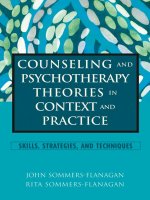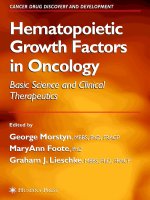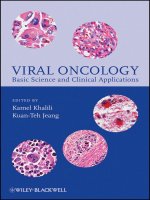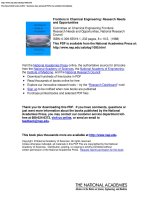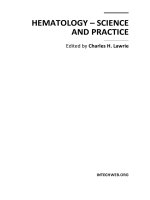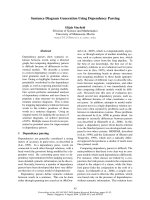ORTHOPEDIC TISSUE ENGINEERING BASIC SCIENCE AND PRACTICE docx
Bạn đang xem bản rút gọn của tài liệu. Xem và tải ngay bản đầy đủ của tài liệu tại đây (16.9 MB, 359 trang )
ORTHOPEDIC
TISSUE
ENGINEERING
BASIC SCIENCE
AND
PRACTICE
EDlTED
BY
VICTORM.
GOLDBERG
ARNOLD
I.
CAPLAN
ORTHOPEDIC
TISSUE
ENGINEERING
BASIC
SCIENCE
AND
PRACTICE
EDITED
BY
VICTOR
M.
GOLDBERG
ARNOLD
I. CAPLAN
Case Western Reserve University
Cleveland, Ohio, U.S.A.
~
MARCEL
DEKKER,
INC.
~
DEKKER
NEW
YORK·
BASEL
Although great care has been taken to provide accurate and current information,
neither the author(s)
nor
the publisher, nor anyone else associated with this publi-
cation, shall be liable for any loss, damage, or liability directly
or
indirectly caused
or
alleged to be caused by this book. The material contained herein
is
not intended
to provide specific advice
or
recommendations for any specific situation.
Trademark
notice:
Product
or
corporate names may be trademarks
or
registered
trademarks and are used only for identification and explanation without intent to
infringe.
Library
of
Congress Cataloging-in-Publication Data
A catalog record for this book
is
available from the Library
of
Congress.
ISBN: 0-8247-4749-6
This
book
is
printed
on
acid-free paper.
Headquarters
Marcel Dekker, Inc., 270 Madison Avenue, New York,
NY
10016, U.S.A.
tel: 212-696-9000; fax: 212-685-4540
Distribution
and
Customer Service
Marcel Dekker, Inc., Cimarron
Road,
Monticello, New
York
12701, U.S.A.
tel: 800-228-1160;
fax:
845-796-1772
Eastern Hemisphere Distribution
Marcel Dekker
AG,
Hutgasse
4,
Postfach 812, CH-4001 Basel, Switzerland
tel: 41-61-260-6300; fax: 41-61-260-6333
World Wide Web
The publisher offers discounts on this
book
when ordered in bulk quantities.
For
more information, write to Special Sales/Professional Marketing
at
the headquarters
address above.
Copyright © 2004
by
Marcel Dekker, Inc.
All
Rights Reserved.
Neither this book nor any
part
may be reproduced
or
transmitted in any form
or
by
any means, electronic
or
mechanical, including photocopying, microfilming, and
recording,
or
by
any information storage and retrieval system, without permission
in writing from the publisher.
Current printing (last digit):
10
9 8 7 6 5 4 3 2 1
PRINTED IN
THE
UNITED
STATES
OF AMERICA
Preface
During
the last three decades,
important
advances have been made in the
available treatments for the loss
of
skeletal tissue as a result
of
trauma
or
disease. The application
of
large skeletal allografts
and
total
joint
replace-
ment have become successful
and
reproducible treatment options. Unfortu-
nately there still
is
a significant incidence
of
failure because
of
mechanical
or
biological complications. A new discipline known as tissue engineering has
developed
that
integrates the concepts
of
the life sciences, such as biology,
chemistry,
and
engineering, with surgical techniques to develop strategies
for the regeneration
of
musculoskeletal tissue. The basic components
of
any tissue-engineered treatment strategy requires viable cells, biomatrices,
and bioactive factors.
The
cells are central to the regenerative process
of
any musculoskeletal tissue. They must be responsive to their environment
and ultimately capable
of
integrating into the host tissue and synthesizing
appropriate extracellular matrix. The biomatrix may have several functions,
including a delivery vehicle for the cells
or
bioactive factors,
or
it may func-
tion as a scaffolding to conduct the host cells and inductive molecules.
Because the musculoskeletal system demands the capability
of
withstanding
functional loads, scaffolds must be capable
of
temporary supportive activ-
ities when used in highly loaded environments such as bone.
The
matrix also
may act as an organizing guiding
component
for the morphogenesis
of
the
engineered tissue.
The
integration
of
the biomatrix
and
cells requires a defi-
nition
of
the optimal number density and distribution
of
the
ceJl
component
relative to the scaffold. Bioactive factors may function as mitogens,
morphogens, or growth factors. These molecules have been shown
iii
MARCEL
DEKKER,
INC.
~
270
Madison
Avenue.
New
York.
New
York
10016
lI!!JI?
iv Preface
experimentally and clinically to be important inducers
of
the regeneration
of
musculoskeletal tissue.
Orthopedic Tissue Engineering: Basic Science and Practice
is
a timely
publication
that
provides a basis
of
both
the basic science and the clinical
application
of
this emerging discipline. The
book
provides a strong basis
for the concepts
of
principles
of
tissue engineering and regeneration
of
mus-
culoskeletal tissue and the application
of
these principles to specific clinical
problems. The publication
is
directed toward a wide audience
of
both
basic
scientists and clinicians involved in the experimental and clinical applica-
tions
of
these new treatments. Medical students and graduate students as
well as established investigators and clinicians in many discipbnes
of
surgery
will
use this book in their activities.
The books
is
divided into sections on basic science and clinical applica-
tions. The chapters in the basic science section address the issues
of
princi-
ples
of
tissue engineering and the role
of
each component, namely,
morphogenic proteins, cells, and biomatrices.
Important
areas
of
bioreac-
tors and clinically applicable animal models in tissue engineering are dis-
cussed for a broad background in tissue engineering/basic science.
The clinical application section addresses each type
of
musculoskeletal
tissue, including bone, cartilage, meniscus, intervertebral disc, and liga-
ment/tendon.
The area
of
gene therapy to enhance both bone and cartilage
repair
is
discussed. The integration
of
the two sections will provide the
reader with a broad background in tissue engineering science and clinical
application. Further, it
will
serve as a source
of
material for investigators
in
each
of
the areas and provide a platform for important future develop-
ments in this emerging clinical discipline. Finally, this publication has
defined the state
of
the science and
art
and, most important, the future direc-
tions and issues
that
must
be
solved for the ultimate successful application
of
regeneration
of
musculoskeletal tissue.
Victor
A1.
Goldberg
Arnold
I. Caplan
MARCEL DEKKER, INC.
~
270 Madison
Avenue.
New
York.
New
York
10016
~
Foreword
The application
of
tissue engineering
III
orthopedics has immense
possibilities yet to be realized. The discipline
of
tissue engineering was
identified
and
generally defined less than
15
years ago,
but
the recognition
of
its potential to impact patient treatment has resulted in a dramatic refo-
cusing
of
research activities into areas
of
unmet
or
unsatisfactory clinical
needs. Already there are tissue-engineered products available in the wound
care field
to
treat
burns
and
chronic wounds, demonstrating the validity
of
this approach. This has been a dramatic success story for such a new field,
and
has been the catalyst for a massive focus
on
basic
and
applied research,
particularly in orthopedics, where the many potential applications are clear
and
necessary.
The field
of
tissue engineering, particularly when applied to ortho-
pedics where tissues often function
in
a mechanically demanding environ-
ment, requires a collaboration
of
excellence in cell
and
molecular biology,
biochemistry, material sciences, bioengineering, and clinical research.
For
success in tissue engineering it
is
necessary
that
researchers with expertise
in
one area have an appreciation
of
the knowledge
and
challenges
of
the
other
areas.
At
the same time, the influx
of
researchers into tissue engi-
neering requires a rapid learning curve
of
the many facets
of
this field to
bring them into a productive mode as soon as possible. Therefore there
is
an obvious need for a text
that
brings to the researcher the critical and
salient points
of
these areas. This book provides an up-to-date knowledge
base for experts and novices alike in tissue engineering, providing a guide
and resource to this rapidly expanding fields.
v
MARCEL DEKKER, INC.
~
270 Madison
Avenue.
New
York.
New
York
10016
~
vi
Foreword
The topics in the
book
comprehensively cover the basic science (cell
and molecular biology) and engineering (biomatrices, bioreactors, biomech-
anics) aspects
that
are
important
in
tissue engineering,
and
considers the
in
vitro an
in
vivo growth environments.
It
also provides insight into the phy-
siology
and
developmental biology
that
can help guide the researcher.
Of
particular importance,
Chapter
9 describes the animal models
that
are being
used
in
translational research, where the efficacy
of
tissue-engineered
products will be determined. Success in an animal model
is
generally a prere-
quisite for moving into clinical trials, yet the models used often are
not
well
understood and unfortunately the interpretation
of
the results are often
overextrapolated. The book also describes the different tissues and the clin-
ical applications
that
tissue engineering can target. These chapters therefore
cover the
breadth
of
tissue engineering in orthopedics, and can educate
all
of
us.
Tissue engineering applications can be considered to act in one
of
several general ways.
The
most simple
is
for the
product
to assist,
or
facili-
tate, the body to repair itself. The second
is
to induce the body to repair
itself. The third
is
to introduce a tissue
that
can remodel
in
vivo to become
functional over time.
The
fourth
is
to provide a frank replacement
that
can
function
at
the time of,
or
soon after, implantation. While the last type
of
application
is
the one most commonly thought
of
as tissue engineering, it
is
by far the most difficult to develop. The first two mechanisms are easier
to apply, and are likely
in
the
short
to medium term to be the way
that
tissue
engineering products
will
have an impact on clinical treatment. Considera-
tion
of
this relatively pragmatic approach may be the way to maintain for-
ward progress
of
this field, while continuing to work toward the ultimate
applications.
Orthopedic applications
of
tissue engineering have the potential to
revolutionize the field. Balancing this with
reality-since
the technical,
regulatory, and commercial challenges may be
substantial-means
that
the introduction
of
new products
is
likely to be slow. Hopefully researchers
will use the experience already gained in tissue engineering to target applica-
tions that minimize the challenges
and
allow progress to be made. Aiming
for the ultimate goals (for example, frank replacement
of
mechanically func-
tional tissues such
as
articular cartilage
and
meniscus, etc.)
is
essential,
but
at
the same time applications
that
are less challenging will almost certainly
lead to more rapid development
of
products
that
can help patients. Replace-
ment
of
tissues with a mechanically demanding function such as cartilage,
meniscus, and ligament
is
likely to be much more difficult with subsequently
long development time. Induction
of
a repair process, already shown to be
successful in wound care tissue engineering, may lead to rapid development
of
products in orthopedics. Every field needs its share
of
success!
MARCEL DEKKER, INC.
~
270 Madison
Avenue.
New
York.
New
York
10016
~
Foreword vii
The
use
of
tissue engineering
in
orthopedics inevitably requires
that
the
product
be commercially viable. The lengthy process times for develop-
ment
and
regulatory approval,
and
the high cost
of
production, must be
weighted.
It
seems likely
that
a strategy that encourages the development
of
relatively simple products with shorter time to
market
and lower cost
of
production will only serve to enhance the field. While these products
may not be as technically challenging
or
attractive to the basic research
scientists and engineers, for those who focus on translational
or
clinical
research, these potential applications can be
just
as rewarding. A
broad
approach is, therefore, necessary.
Tissue engineering
is
still in its infancy, but
is
moving into a more
rigorous, science-driven field. This
is
welcomed and should be encouraged,
and progress will surely be made not only in the areas
that
are already tar-
geted,
but
by new researchers
not
burdened
by
history
and
dogma. There
is
therefore a need for both the safe and incremental, as well as the high-risk
entrepreneurial approaches.
The visionary leadership shown by those who introduced the field
of
tissue engineering,
and
by those who early on recognized its immense poten-
tial
in
orthopedics, must now be enhanced by a new
group
of
scientists and
engineers with new vision. These researchers
will
need to work
at
the fore-
front
of
their own technical discipline as well as in a multi-disciplinary envir-
onment, having an advanced appreciation
of
technical fields
not
their own.
This high-level collaboration
among
researchers in different fields will surely
result in the development
of
new methods
and
products
that
can address the
clinical challenges in orthopedics. The future
is
very bright!
Anthony Ratcliffe
Gail Naughton
San Diego, California,
U.
S.
A.
MARCEL DEKKER, INC.
~
270 Madison
Avenue.
New
York.
New
York
10016
~
MARCEL DEKKER, INC.
~
270
Madison
Avenue,
New
York.
New
York
10016
~
Contents
Preface
Foreword
Contributors
PART I BASIC SCIENCE
I. Principles
of
Tissue Engineering and Regeneration
of
Skeletal Tissues
Victor M. Goldberg and Arnold I. Caplan
III
V
X
III
2.
Tissue Engineering and Morphogenesis:
Role
of
Morphogenetic Proteins
11
A.
H.
Reddi
3.
Cell-Based Approaches to Orthopedic Tissue Engineering
21
E.
J.
Caterson,
Rocky
S. Tuan, and Scott
P.
Bruder
4.
Intraoperative Harvest and Concentration
of
Human
Bone Marrow Osteoprogenitors for Enhancement
of
Spinal Fusion
James
E.
Fleming, Jr., George
F.
Muschler, Cynthia Boehm,
fsador
H. Lieberman, and Robert
F.
McLain
5.
Molecular Genetic Methods for Evaluating Engineered Tissue
Matthew L. Warman
51
67
ix
MARCEL DEKKER, INC.
~
270 Madison
Avenue.
New
York.
New
York
10016
~
x
6.
Biodegradable Scaffolds
Johnna
S.
Temenoff, Emily
S.
Steinbis,
and Antonios
G.
Mikos
7.
Biomechanical
Factors
in Tissue Engineering
of
Articular Cartilage
Farshid Gui/ak
8.
Bioreactors for Orthopedic Tissue Engineering
G.
Vunjak-Novako
vic,
B. Obradovic,
H.
Madry,
G.
Altman, and
D.
L.
Kaplan
9.
Clinically Applicable Animal Models
in Tissue Engineering
Ernst
B.
Hunziker
PART
II
CLINICAL APPLICATION
10.
Bone Tissue Engineering: Basic Science
and
Clinical Concepts
Safdar
N.
Khan and Joseph M. Lane
11.
Articular Cartilage: Overview
Joseph A. Buckwalter
12.
Cartilage:
Current
Applications
B.
Kinner and M. Spector
13.
Tissue Engineering
of
Meniscus
Brian Johnstone, Jung Yoo, Victor Goldberg,
and Peter Angele
14.
Tissue Engineering
of
Intervertebral Disc
Jung Yoo and Brian Johnstone
IS. Clinical Applications
of
Orthopedic
Tissue Engineering:
Ligaments
and
Tendons
Lee
D.
Kaplan and Freddie
Fu
16.
Functional Engineered Skeletal Muscle
Robert
G.
Dennis
Contents
77
105
123
149
161
179
201
237
249
261
"li
t
"
~
~
c:
OIl
275
'C
::l
4:
U
.5
,.
~
"
Cl
~
~
cQJ
:a
.~
C<
0
U
MARCEL DEKKER, INC.
~
270 Madison
Avenue.
New
York.
New
York
10016
~
Contents
17.
Gene Therapy to Enhance Bone and
Cartilage Repair
Jay R. Lieberman
Index
xi
305
323
MARCEL DEKKER, INC.
~
270 Madison
Avenue.
New
York.
New
York
10016
~
MARCEL DEKKER, INC.
~
270
Madison
Avenue,
New
York.
New
York
10016
~
Contributors
G. Altman Tufts Unjversity, Medford, Massachusetts, U.S.A.
Peter Angele University
of
Regensburg, Regensburg, Germany
Cynthia Boehm The Cleveland Clinic
Foundation,
Cleveland, Ohio, U.S.A.
Scott
P.
Bruder Case Western Reserve University, Cleveland, Ohio, and
DePuy, Inc., a Johnson
& Johnson Company, Raynham, Massachusetts,
U.S.A.
Joseph
A.
Buckwalter Unjversity
of
Iowa College
of
Medicine, Iowa City,
Iowa, U.S.A.
Arnold I. Caplan Case Western Reserve Unjversity, Cleveland, Ohio,
U.S.A.
E.
J.
Caterson
Thomas
Jefferson University, Philadelphia, Pennsylvania,
U.S.A.
Robert G. Dennis
Harvard-MIT
Division
of
Health Sciences and
Technology,
and
MIT
Artificial Intelligence Laboratory, University
of
Michigan, Ann Arbor, Michigan, U.S.A.
James
E. Fleming,
Jr.
The
Cleveland Clinic
Foundation,
Cleveland, Ohio,
U.S.A.
xiii
MARCEL DEKKER, INC.
~
270 Madison
Avenue.
New
York.
New
York
10016
~
xiv Contributors
Freddie
Fu
University
of
Pittsburgh School
of
Medicine, Pittsburgh,
Pennsylvania, U.S.A.
Victor M. Goldberg Case Western Reserve University, Cleveland, Ohio,
U.S.A.
Farshid Guilak Duke University Medical Center,
Durham,
North
Carolina, U.S.A.
Ernst B. Hunziker University
of
Bern, Bern, Switzerland
Brian Johnstone Research Institute
of
University Hospitals, and Case
Western Reserve University, Cleveland, Ohio, U.S.A.
D. L. Kaplan Tufts University, Medford, Massachusetts, U.S.A.
Lee
D.
Kaplan University
of
Wisconsin School
of
Medicine, Madison,
Wisconsin, U.S.A.
Safdar N. Khan Hospital for Special Surgery, New York, New York,
U.S.A.
B. Kinner Brigham and Women's Hospital, Harvard Medical School, and
VA
Boston Healthcare System, Boston, Massachusetts, U.S.A.
Joseph
M.
Lane Weill Medical College
of
Cornell University and
Hospital for Special Surgery, New York, U.S.A.
Isador H. Lieberman The Cleveland Clinic Foundation, Cleveland, Ohio,
U.S.A.
Jay R. Lieberman David Geffen School
of
Medicine
at
UCLA, Los
Angeles, California, U.S.A.
H. Madry Saarland University, Homburg-Saar, Germany
Robert F. McLain The Cleveland Clinic Foundation, Cleveland, Ohio,
U.S.A.
Antonios G. Mikos Rice University, Houston, Texas, U.S.A.
George F. Muschler The Cleveland Clinic Foundation, Cleveland, Ohio,
U.S.A.
MARCEL DEKKER, INC.
~
270 Madison
Avenue.
New
York.
New
York
10016
~
Contributors
B. Obradovic
University
of
Belgrade, Belgrade, Yugoslavia
xv
A.
H. Reddi Center for Tissue Regeneration and Repair, University
of
California, Davis, School
of
Medicine, Sacramento, California, U.S.A.
M. Spector Brigham and Women's Hospital,
Harvard
Medical School,
and VA Boston Healthcare System, Boston, Massachusetts, U.S.A.
Emily
S.
Steinbis Rice University, Houston, Texas, U.S.A.
Johnna S. Temenoff Rice University, Houston, Texas, U.S.A.
Rocky
S.
Tuan Thomas Jefferson University, Philadelphia, Pennsylvania,
and National Institute
of
Arthritis, and Musculoskeletal and Skin
Diseases, National Institutes
of
Health, Bethesda, Maryland, U.S.A.
G. Vunjak-Novakovic
Harvard-MIT
Division
of
Health Sciences
and Technology, Massachusetts Institute
of
Technology, Cambridge,
Massachusetts, U.S.A.
Matthew L. Warman Case Western Reserve University School
of
Medicine, Cleveland, Ohio, U.S.A.
Jung Yoo Research Institute
of
University Hospitals, and Case Western
Reserve University, Cleveland, Ohio, U.S.A.
MARCEL DEKKER, INC.
~
270 Madison
Avenue.
New
York.
New
York
10016
~
MARCEL DEKKER, INC.
~
270
Madison
Avenue,
New
York.
New
York
10016
~
MARCEL DEKKER, INC.
~
270
Madison
Avenue,
New
York.
New
York
10016
~
MARCEL DEKKER, INC.
~
270
Madison
Avenue,
New
York.
New
York
10016
~
1
Principles
of
Tissue Engineering and
Regeneration
of
Skeletal Tissues
Victor
M.
Goldberg and Arnold
I.
Caplan
Case Western Reserve
University,
Cleveland,
Ohio, U.S.A.
I.
INTRODUCTION
There
has
been
significant
improvement
in technologies to
reconstruct
musculoskeletal defects as a
result
of
trauma
or
disease.
During
the
last
few decades,
there
has
been
widespread
use
ofbone-banked,
processed
skel-
etal allografts
to
reconstruct
large deficits
of
bone
and
cartilage
(1,15,17,19,29,41) with
outcomes
at
intermediate
foHow-up providing
85% satisfactory results (15,17,20,23,25).
However,
there
still is a signi-
ficant
incidence
of
nonunions
and
graft failures, which usuaHy
require
additional
surgical
intervention
and
result
in
additional
morbidity.
Additionally,
the
cost
and
availability
of
graft materials
and
some im-
munological issues still have
not
been completely resolved.
During
the
last 30 years,
total
joint
arthroplasty
has
become
a
repro-
ducible
and
a consistently successful surgical
treatment
with 97% satis-
factory
outcome
at
8 years
(16,28,38-40).
The
successful
outcome
has
encouraged
the
application
of
the technology to younger,
more
active
patients. As a result, an
increased
incidence
of
failure with
wear
of
the
articulating
surface
and
loosening
of
the
implants
has
been
reported
(39).
MARCEL DEKKER, INC.
~
270 Madison
Avenue.
New
York.
New
York
10016
~
2
Goldberg
and
Caplan
Although
great
strides have
been
made
to improve
materials
and
surgical
techniques,
the
failure
rate
in these
younger
patients
still
approaches
10%
in
long-term
follow-ups.
The
ultimate goal
of
any
treatment
that
addresses
musculoskeletal tissue loss is
the
restoration
of
the
morphology
and
function
of
the
lost
tissue.
The
recent
emergence
ofa
new discipline,defined
as tissue engineering,
combines
aspects
of
cell biology, engineering,
materi-
als science,
and
surgery with
the
outcome
goal
to
regenerate functional
skeletal tissues as
opposed
to
replacing
them
(4,5,9,21,24,35,37).
Repair
and
regeneration
of
skeletal tissues are fundamentally differ-
ent
processes
(8,10,33).
In
many situations, scar, which is the
result
of
rapid
repair,
can
function satisfactorily, such as in
the
early
phases
of
bone
restoration.
By
contrast,
regeneration
is
a relatively slow
process
that
ulti-
mately
results in a
duplication
of
the
tissue
that
has
been
lost.
Regeneration
is
rarely
seen
in adults
but
is
evident
in very young children.
Such
regenera-
tion
appears
to
recapitulate
some
of
the key steps
that
occur
in
embryonic
development.
Our
approach
to
musculoskeletal tissue
regeneration
is
to
use principles
of
tissue engineering
that
are
based
upon
the
premise
that
there
are
important
constituents
that
distinguish
the
fetal
environment
from
that
in adults
and
by mimicking
aspects
of
these
fetal microenvi-
ronments,
we
can
engineer
the
restoration
of
adult tissue
(8-10,27,31).
A
broader
understanding
of
and
attention
to
basic
principles
of
tissue
engineering will result in
enhanced
success in regenerating specific tissues.
The
important
constituents
of
embryonic
development
include a high
pro-
portion
of
undifferentiated
progenitor
cells with a highercell-to-extracellu-
lar matrix ratio
than
in
the
fully formed
adult
tissue,
and
the
capability
to
mechanically
protect
embryonic
mesenchymal
tissue from
surrounding
tis-
sues, which is very difficult in adults
(8,9).
Further,
regeneration
implies
the
establishment
of
a
sequence
of
signals
to
allow for the
appropriate
dif-
ferentiation
and
maturation
cascade
to
proceed.
Additionally,
the
forming
tissues are continually
under
the
influence
of
inductive cytokines
that
pro-
vide
the
biological cues for
molecular
and
cellular
constituents
at
each
stage
of
development. Finally,
the
regenerated
tissue
must
establish
an
appropri-
ate
turnover
dynamic
with
the
continued
capacity
to
grow.
These
consid-
erations
clearly
impose
certain
functional
constraints
on
the
maturing
tissue
but
this regenerating
and
evolving tissue
should
be
superior
to
repair
tissue, which
does
not
allow
growth
and
provides little
long-term
benefit.
Importantly,
regeneration
differs significantly from
repair
in
aspects
of
mechanical influences on
the
tissue. Musculoskeletal tissue is highly
responsive
to
its
mechanical
environment,
and
it
is
only
through
the
inter-
action
of
mechanical
and
biological cues
that
tissue differentiation
proceeds
to
an
appropriate
morphological
and
biochemical
character
that
successfully functions in highly loaded situations.
This
functional
MARCEL DEKKER, INC.
~
270 Madison
Avenue.
New
York.
New
York
10016
~
Principles of Tissue Engineering
3
constraint
imposes unusual
demands
on
tissue engineering strategies for
skeletal tissues.
II. PRINCIPLES OF TISSUE ENGINEERING
The
basic
component
of
any tissue engineering strategy is the use,
either
in
combination
or
separately,
of
cells,
biomatrices
or
scaffolds/delivery
vehicles,
and
signaling molecules
that
provide
the
biological cues for
the
progression
of
cellular differentiation
and
its site-specific functional
modulation
(9,27,33,37). Significant issues remain for
each
component
that
must be
addressed
to develop successful and realistic tissue engineer-
ing
treatment
strategies. Central to
our
strategies
is
the
need for cells
(3,8,21,22,31,33,35,45-47).
Significant issues
that
remain
include the
source
of
these cells, the
number
and density, and,
most
important,
their
age,
phenotypic
character,
and
developmental potency. We have
put
forth
the hypothesis
that
mesenchymal
stem
or
progenitor
cells possess the
appropriate
developmental potential, are responsive to local cueing, and
are capable
of
ultimately differentiating into
the
appropriate
required phe-
notype
(8,9,27).
By
contrast,
adult differentiated cells
are
generally less
responsive to mechanical and biological cues and may
not
be available in
the
appropriate
quantities
to
achieve
the
desired tissue density.
Biomatrices, scaffolds,
or
delivery vehicles
are
important
com-
ponents
of
tissue engineering strategies.
Both
synthetic and
natural
mate-
rials have been used as delivery vehicles for cytokines
or
cells
or
both
(2,21,22,26,27,32,42,43,47).
It
is
still
not
clear
what
the
ideal physical,
chemical, and mechanical
characteristics
of
the
carrier
should
be
for each
specific tissue application.
Ceramics,
polymers
oflactic
and
glycolic acid,
collagen gels, and
other
natural
polymers have
been
used to fabricate deliv-
ery vehicles
and
have been
tested
both
in vivo
and
in vitro (2,21,32,47).
The
optimal
properties
of
biomatrices
for
each
implantation
site
must
be
defined
and
include
their
biodegradability, porosity, bonding capabilities,
remodeling capacity, surface characteristics,
and
overall
architecture
(9,30). Again,
foremphasis,
there
are critical
requirements
for
each
specific
tissue
implantation
site.
Most
important,
since
regeneration
is a multistep
process with sequential cues, delivery vehicles should, in theory, possess
multifunctional
properties
including intrinsic inductive capacities during
early events,
modulation
capacities during the process, and, finally, the
capabilityto
contribute
to
the
control
of
the integration
ofthe
newly formed
tissue
into
that
of
the
host
(44). Ideally, delivery vehicles should be engi-
neered
to
sequentially release discrete
components
that
will
accomplish
these
specific functions as the scaffold degrades to facilitate the seamless
regeneration
of
specific musculoskeletal tissues.
MARCEL DEKKER, INC.
~
270 Madison
Avenue.
New
York.
New
York
10016
~
4 Goldberg and Caplan
Bioactive factors
or
cytokines have
been
used as single molecules
although
multiple
components
might be
more
effective (9,10,37). Since
the
successful engineering
of
a regenerative tissue
depends
on a
cascade
of
events, multiple factors
could
be
expected
to
enhance
the
process.
Signifi-
cant
in
vitro
and
in vivo studies indicate
that
powerful biological agents
such
as transforming
growth
factor-B, fibroblastic
growth
factors,
and
bone
morphogenetic
proteins
may
enhance
the
reparative
mechanisms
of
otherwise
inactivetissue(24,37). Although during
the
last
decade
significant
advances have
been
made
in
understanding
the
function
of
these
molecules,
there still are
unanswered
issues.
These
include the
choice
of
specific mole-
cules for specific
indications
and
the
correct
dose, timing,
and
sequence
of
administration.
Again, for
the
regeneration
of
specific musculoskeletal
tissues
there
are
additional
mechanical
and
biological
requirements.
The
musculoskeletal system is unique in
that
its
major
function is to
provide weight-bearing
potential,
which involves a complex, multifactorial
environment
that
places the regenerating tissue
under
enormous
mechani-
cal disadvantage.
Therefore,
an
important
question
that
remains
to
be
answered
is
whether
a tissue-engineered
composite
of
cells, scaffolds,
and
bioactive molecules
should
be
manufactured
in an in vivo site by providing
the
appropriate
mechanical
and
biological
environment
or
whether
the
sequence
of
events should be
controlled
in vitro (21,44).
Ultimately
the
use
oflarge
structural
tissues
to
replace
destroyed
segments of, for example,
osteoarticular
structure,
may well require
bioreactors
to
manufacture
materials
that
can
withstand
the
detrimental
loading
environment
in vivo.
Additionally,
the
use
of
genetic
engineering technology may
provide
an
additional strategy
to
facilitate a
complete,
integrative
regeneration
of
musculoskeletal
structure.
III. RULES OF TISSUE ENGII\lEERING
InitiaJly, tissue engineering
approaches
and
concepts
were empirical.
It
has
only
been
recently, with focus
on
the
scientific principles,
that
progress
has
been
made
toward
successful
replacement
of
lost tissue.
Although
we
have
discussed
the
necessity
of
the use
of
cells,
biomatrices,
and
bioactive
factors,
our
central
hypothesis
is
that
the
management
of
cells is critical to
any successful tissue engineering strategy since cells are responsible for
tissue fabrication.
Philosophically,
the
increase in life
expectancy
requires biological
solutions
to
orthopedic
problems
that
were previously
managed
with
mechanical
solutions. We have developed
over
the
years, from
our
research
endeavors, a
number
of
rules
that
we believe
are
critical in
the
refinement
of
successful cell-based tissue engineering
treatment
strategies (7).
MARCEL DEKKER, INC.
~
270 Madison
Avenue.
New
York.
New
York
10016
~
Principles
of
Tissue
Engineering
5
Rule
1:
Physically replace the excised tissue withbiologically
matched
tissue.
This
requires
that
precise
and
discrete boundaries be established to
fit the volume required
by
the excised
or
damaged tissue.
Rule
2:
Regenerate
the
engineered tissue as
opposed
to repairing the
excised
or
missing tissue.
Rule
3:
Regulate
or
integrate the neo tissue with
the
host
tissue in a
seamless
manner
to
reestablish
natural
function.
Rule 1addresses
the
central
concepts
that
have
been
developed in
our
laboratory, namely
that
key features
of
embryonic tissue development
should be used in designingtissue engineering strategies.
Embryonic
devel-
opment
has been shown to be a
continuum
of
genetically
programmed
changes
that
produce
specific tissues with
restricted
functions (12). This
program
provides
important
biological cues
throughout
the entire life
of
the individual. Specifically, the tissue-engineered
replacement
must
pro-
duce a
structure
that
fills the entire space, since the signals
or
the
receptors
for these signals
present
in embryos
to
establish morphological
boundaries
are
not
available in adults.
The
neo tissue
must
be able to remodel to even-
tually
match
the
morphology, biology,
and
mechanical function
of
the
host
tissue.
If
allogeneic cells
are
used in
the
tissue engineering strategy, they
must
either
be
replaced
by
host
cells
or
exhibit similar developmental
potential
to
that
of
the host.
The
accessibility
of
nutrients
to the neo tissue is critical to the long-
term
survivability
of
the
construct.
In
the embryonic environment, because
of
the
scale,
nutrient
accessibility
is
rarely a problem. However, since the
scale
of
tissue engineering
replacements
is manyfold
larger
in adults, nutri-
ent
accessibility
can
be limiting.
This
usually involves the
management
of
the initial inflammatory response
that
occurs with any wound. Specifically,
a balance between revascularization
and
fibrous isolation
of
the neo
tissue
must
be accomplished.
For
example,
bone
regeneration requires the
reestablishment
of
functional vasculature while inhibition
of
vasculariza-
tion will result in
either
chondral
or
fibrous tissue
replacement
(6,13,18,34).
Regeneration,
rather
than
repair, is the
central
goal
of
any tissue engi-
neering strategy.
Repair
is
usually a
rapid
occurrence
that
is
required
for
the survival
of
the individual
but
is not necessary for its
optimal
function.
Repair
usually results in a dense connective tissue
scar
that
fills the space;
however, it may
not
be responsive
to
the
highly loaded mechanical environ-
ment
required
of
musculoskeletal tissue.
In
very young animals where
there
are high tissue
growth
and
turnover
rates, this
repair
tissue may be slowly
replaced by normal, morphologically specialized tissue.
Regeneration
is a
slow process
that
is usually characterized by
the
recapitulation
of
aspects
MARCEL DEKKER, INC.
~
270 Madison
Avenue.
New
York.
New
York
10016
~
6
Goldberg and Caplan
of
embryonic development.
For
example, skeletal muscle
regeneration
exhibits distinctive
transitions
of
molecular
isoforms
of
glycosaminogly-
cans,
contractile
proteins,
actins,
and
myosins, where
the
embryonic
iso-
form is
replaced
by a
neonatal
form
that
is
then
replaced
by
the
adult
molecule (11). All
of
these
isoforms are
distinct
gene
products
and
appear
in
regenerating
muscle
on
an
accelerated
timetable
of
weeks as
compared
to
many
months
to
observe
these
transitions
in
normal
development
(14).
Regeneration
also involves
the
transition
from a relatively high
progeni-
tor-cell-to-extracellular-matrix
ratio
to
a specialized musculoskeletal tis-
sue with a low cell-to-extracellular-matrix ratio.
The
extracellular
matrix
is
a
major
determinant
of
the skeletal
tissue's
chemical,
physical,
and
mechanical
properties.
The
neo tissue
must
be
capable
of
matching
the
dynamic biological
mechanisms
oftuTllover
experienced
by
the
host
tissue
in the
short
and
long term.
For
example, in young recipients,
regenerated
tissue
must
be
capable
of
growth, while in
older
recipients the regener-
ated tissue
must
be
capable
of
downsizing
that
occurs
with aging
of
the
organism.
The
tissue
engineered
construct
must
be
either
immunomatched
with
the
host
or
protected
from
the
immunological survey
and
responses
of
the host.
The
integration
of
regenerated
tissues is critical
to
the
load-bearing
function
of
most
musculoskeletal
structures.
The
regenerated
tissue
must
match
biologically, morphologically, and mechanically to
the
host
tissues
or
it ultimately will fail.
For
example,
the
hyaline cartilage
ofa
weight-bear-
ing surface
of
a
diarthrodial
joint
must
be
integrated
with
the
neo cartilage
of
regenerated
tissue.
Further,
the
new tissue
must
be
subject
to
the
same
regulation
of
its growth
or
metabolism
as
the
host
tissue,
or
a
mismatch
may result in
disproportionate
growth
or
functional
discontinuity
resulting
in
structural
failure. Finally, the
phenotypic
expression
of
the
implanted
cells
must
match
the
host
cells.
For
example,
it
is
insufficient for
the
cells
to
merely
express
a cartilage
program
that
expresses type
II
collagen
and
aggrecan, since cartilages
of
the
articular
surface
of
the
knee
are
signifi-
cantly different when
compared
to the
meniscus
or
to
the
ear
(36).
IV. SUMMARY
The
ultimategoal
of
tissue engineeringis the
complete
integrative regenera-
tion
of
musculoskeletal
structures
providing biological solutions for clini-
cal
problems.
The
management
of
cells,
either
in vitro
or
in vivo, is
the
cornerstone
offunctional
tissue engineering.
The
integration
ofthese
cells
with
biomatrices
and
their
sensitivity
to
growth
molecules
must
be
accom-
plished
to
provide
the
necessary
molecular
and
mechanical
cues
required
for
the
functional
integration
of
the
neo tissue with
the
host. Regenerative
MARCEL DEKKER, INC.
~
270 Madison
Avenue.
New
York.
New
York
10016
~
